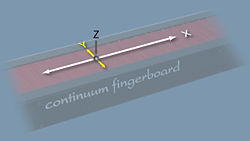- Continuum (instrument)
-
Continuum Fingerboard
The full-size Continuum FingerboardManufactured by Lippold Haken Dates c. 2002-present Price Full size: $5290[1]
Half size: $3390Technical specifications Polyphony 16 voices Input/output External control MIDI, AES3 The Continuum Fingerboard or Haken Continuum is a music performance controller developed by Lippold Haken, a professor of Electrical and Computer Engineering at the University of Illinois, and sold by Haken Audio, located in Champaign, Illinois.[2]
The Continuum Fingerboard was initially developed over the period of 1990 to 2000 at the CERL Sound Group at the University of Illinois to control sound-producing algorithms on the Platypus audio signal processor[3] and the Kyma/Capybara workstation.[4]
In 2002, the first commercial version of the Continuum Fingerboard used IEEE-1394 (FireWire) or MIDI connections to control a Kyma sound design workstation or a MIDI synthesizer module. Later versions added a control voltage option to permit control of analog modular synthesizers.
The most recent model can generate audio directly, but it is still primarily designed to be a MIDI controller (the IEEE-1394 connection that was present on earlier models has been removed).
Contents
Specifications
The Continuum features a touch-sensitive neoprene playing surface measuring approximately 19 centimetres (7.5 in) high by either 137 centimetres (54 in) long for a full-size instrument, or 72 centimetres (28 in) long for a half-size instrument. The surface allows a pitch range of 9350 cents (about 7.79 octaves) for the full-size instrument, and 4610 cents (about 3.84 octaves) for the half-size instrument. The instrument has a response time of 1.33 ms.[5]
Sensors under the playing surface respond to finger position and pressure in three dimensions and provide pitch resolution of one cent along the length of the scale (the X dimension), allowing essentially continuous pitch control for portamento effects and notes that are not in the chromatic scale, and allowing for the application of vibrato or pitch bend to a note. A software "rounding" feature enables pitch to be quantized to the notes of a traditional equal-tempered scale, just scale or other scale to facilitate in-tune performance, with the amount and duration of the "rounding" controllable in real time.[6]
The Continuum also provides two additional parameters for the sound: it is able to transmit the finger pressure on the board as a MIDI value, as well as the finger's vertical position on the key. These parameters are independently programmable; a standard configuration is where position on the X-Axis (lengthwise) on the instrument corresponds to pitch, position on the Y-Axis (widthwise) corresponds to a timbre shift, and position on the Z-Axis (vertically) corresponds to a change in amplitude. The Continuum is capable of polyphonic performance, with up to 16 simultaneous voices.
Continuum players
A major proponent of the Continuum in contemporary music is Dream Theater's keyboardist, Jordan Rudess. He has used the instrument extensively live and in the studio with Dream Theater. He plays the Continuum in the songs "Octavarium" and "Sacrificed Sons" from the album Octavarium, "The Dark Eternal Night" and "Constant Motion" from 2007's Systematic Chaos, and "A Nightmare to Remember", and "The Shattered Fortress", from the album Black Clouds & Silver Linings. Rudess also used the Continuum on Dream Theater's live releases Score and Chaos in Motion, and his 2007 solo album The Road Home.
Another high profile advocate of the Continuum Fingerboard is Sarth Calhoun, who uses it in his work with Lucibel Crater and Lou Reed. In the Metal Machine Trio both Calhoun and Reed use Continuum Fingerboards on stage.[7]
Indian composer A.R. Rahman's 2007 Third Dimension tour of North America featured the Continuum.[8] He used the Continuum in a piece he composed for the Changing Notes Concert held in Chennai, and in the song "Rehna Tu" in the 2009 movie Delhi-6 and the new version of "Mile Sur Mera Tumhara".[9] He also used it in his score of the film Enthiran and in the track "Acid Darbari" from the Academy Award nominated soundtrack of 127 Hours.[10]
The Continuum was used by John Williams for his score to Indiana Jones and the Kingdom of the Crystal Skull.[11]
Other musicians using the Continuum include Jordan Rudess, John Paul Jones, Randy Kerber and Amon Tobin.[12]
References
- ^ "NAMM: Continuum Fingerboard MIDI Controller". Harmony Central. 2004-01-26. http://namm.harmony-central.com/WNAMM04/article/Haken/Continuum.html. Retrieved 2009-07-08.
- ^ "Dr. Lippold Haken". http://www.cerlsoundgroup.org/CSGdesc/LippoldHome.html. Retrieved 2008-04-06.
- ^ Scaletti, Carla (1989). "The Kyma/Platypus Computer Music Workstation". Computer Music Journal (MIT Press) 13 (2): 23–38. JSTOR 3680038.
- ^ Lippold Haken; Radi Abdullah and Mark Smart (Oct. 1992). "The Continuum: A Continuous Music Keyboard". Proceedings of the International Computer Music Conference. San Jose: International Computer Music Association. pp. 81-84.
- ^ "Haken Audio". http://www.hakenaudio.com/Continuum/html/overview/Intro.html. Retrieved 2008-04-06.
- ^ Lumma, Carl. "Haken Audio Continuum". KeyboardMag. http://www.keyboardmag.com/article/haken-audio-continuum/Aug-04/1874. Retrieved 2009-07-08.
- ^ Ratliff, Ben (2009-04-25). "All Those Sounds From the Stage: Processed, and Not Always Pretty". The New York Times. http://www.nytimes.com/2009/04/25/arts/music/25reed.html. Retrieved 2010-04-30.
- ^ Eichman, Lauren (2007-06-13). "ECE PROFESSOR’S INSTRUMENT FEATURED ON WORLD-RENOWNED MUSICIAN’S TOUR". University of Illinois. http://www.ece.illinois.edu/mediacenter/article.asp?id=233. Retrieved 2011-01-31.
- ^ Eichmann, Lauren (2007-06-13). "ECE Professor’s instrument featured on world-renowned musician’s tour". ECE Illinois. http://www.ece.uiuc.edu/news/headlines/hl-fingerboard.html. Retrieved 2008-04-06.
- ^ Music Aloud. "127 Hours - Music Review". Music Aloud. http://www.musicaloud.com/2010/11/03/127-hours-music-review. Retrieved 2010-11-03.
- ^ Eichmann, Lauren (2008-05-21). "Indiana Jones and the incredible Continuum Fingerboard". ECE Illinois. http://engineering.illinois.edu/news/?xId=074108320784. Retrieved 2008-05-21.
- ^ Kim, Peter (2008-03-05). "'Indiana Jones' movie to use professor's musical invention". DailyIllini.com. http://media.www.dailyillini.com/media/storage/paper736/news/2008/03/05/News/indiana.Jones.Movie.To.Use.Professors.Musical.Invention-3251800.shtml. Retrieved 2008-04-06.
External links
Categories:- Electric and electronic keyboard instruments
- Continuous pitch instruments
- Keyboard instruments
Wikimedia Foundation. 2010.


